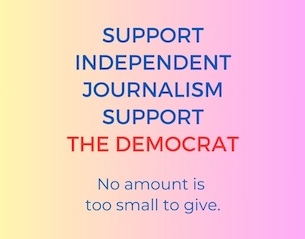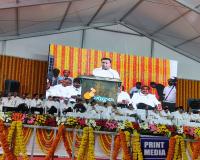- More
- Take Local Stories Across The Globe Using Digital Medium : Kounteya Sinha
Take Local Stories Across The Globe Using Digital Medium : Kounteya Sinha
By Poushali Banerjee Kolkata: The day nine of the #MediaNext 2020 organized by the Kolkata-based Adamas University saw distinguished photojournalists edifying media aspirants on photography in the digital times and the impact of COVID 19 on it. Kounteya Sinha spoke on storytelling through images, and the students learned a lot from the valuable experiences shared by

By Poushali Banerjee
Kolkata: The day nine of the #MediaNext 2020 organized by the Kolkata-based Adamas University saw distinguished photojournalists edifying media aspirants on photography in the digital times and the impact of COVID 19 on it. Kounteya Sinha spoke on storytelling through images, and the students learned a lot from the valuable experiences shared by him. Prof. Ujjwal Kumar Chowdhury moderated the session, and he is the Pro Vice-Chancellor and Dean, School of Media, Communication and Fashion, Adamas University, and Amit Chawla, HOD, Dept. of Mass Communication, School of Media, Film, and Entertainment, Sharda University.
The conclave is being organized in association with Sharda University, Birla Global University, DME, AIMEC, Lok Samvad Sansthan, exchange4media, ABP Education, and IndiaReal.in, The conclave is being organized for a period of 10 days from June 1, 2020, to June 10, 2020. Each day of the conclave focuses on one specialized domain of the Media and Entertainment (M&E) industry and the impact of the COVID -19 pandemic on that specific domain.
Kounteya Sinha is multiple award-winning journalists, the former editor of Times of India London and Europe. A globally revered photographer, European Union Diaspora Fellow, globe trotter, and a storyteller, he is a man who is known for his powerful storytelling ability through words and also images. Kaunteya Sinha articulated, “Storytelling is the ability to dig a story out of the burrow and tell it to the world. This gives me the greatest sense of achievement. There are millions of stories waiting to be found”.
Addressing the budding media professionals, he remarked, “The world is brimming with stories today. Stories are found and told in the real world – so step out, don’t keep sitting at home. The most important thing is to develop the ability to hunt stories as a journalist”.
He said that he doesn’t work for a particular newspaper, and this is how things will be in the post-COVID digital world. “Instead, I break stories on the internet. I have the liberty to do it in my own way,” he stated.
Project “Bismillah”
His ‘Project Bismillah’, meaning ‘In God’s name, we start’ is a prayer said before having supper. The project is a series of images or shots taken in Kashmir, in which he has made an effort to document their lives. With the images, he conveys a tremendous message, calling our attention to the issue of Kashmir. He has spent a huge amount of time shooting and interacting with the local people, who have lost their bread, occupation – everything but their smile. He hopes to reach out to the world with his pictures and revive normalcy in their lives.
Speaking excitedly on his ‘Project Bismillah,’ he showed the audience the road ahead and said, “It is my way of fighting propaganda with storytelling using creative arts. I have invested my mind and money. With the use of animation and photography, I try to present before the world the real Kashmir – the paradise on Earth. I work with the aim of breaking the stereotypical image of Kashmir, mostly associated with mayhem and terrorism. But this is not true. I have visited Kashmir 13 times and tried to dig out stories as much as possible. One needs to visit my Facebook page on ‘Project Bismillah’ to know more about it as a picture is worth than a thousand words”.
“Project Bismillah is not a political statement; it is not a stand against the government. It is a very simple idea to improve the living conditions of the people of Kashmir by showing the world its beauty and innocence. The primary occupation of the People of Kashmir is tourism, which has suffered a great setback. My hard work has begun to show rewards, and I urge more people to join hands for the cause,” he added.
The mantra for the post-COVID era
Many students apprehensive about their career asked him about the challenges they would face in the post COVID era. To which he replied, “Every photograph is a story irrespective of the genre. Practice photography in the real world – use the real world as the backdrop. You need to tell brilliant hardcore stories with your images. This is the only way one can adapt, survive, and conquer”.
“The entire world is panicking and uncertain about the future. But these troubled times are a great opportunity for storytelling. Whenever the world faces adversity like COVID or the cyclone, which happened in Kolkata, all these are opportunities for storytelling. Great stories come out of the burrows where they might be hiding for years. The storyteller is the medium between the world of visibility and invisibility. Society needs more people like us to update them with the happenings in the world”, he informed.
He shared many of his valuable experiences of travelling around the world and uncovering stories and bestowed knowledge to young minds. He reiterated the mantra of taking local stories across the globe. He said, “The story which you make, though local, must be a having a global aspect, it should appeal to a larger audience.”
His Journey
He calls himself an urban nomad who has traveled to over 100 countries. He has authored many books and been the literature festival director, design week mentor, director of The Kolkata International Photography Festival.
He has interviewed presidents, prime ministers, royalty, almost 50 Nobel laureates, whistleblowers like Julian Assange, tech giants like Bill Gates and his wife Melinda, among others. He was the first Indian journalist to report on the Nobel Prize from Stockholm three years in a row and also covered the recent Russian conflict in Ukraine from ground zero. He became the world’s first European Union Diaspora Fellow under and traveled to 11 European countries over three months, discovering and documenting the unknown lives of Indians who have made the EU their home.
ooo











